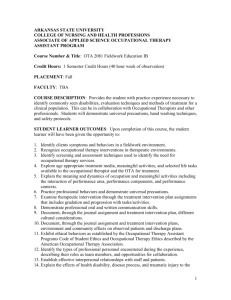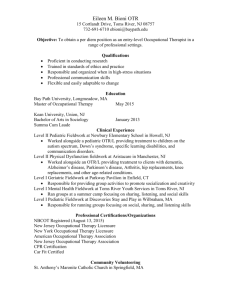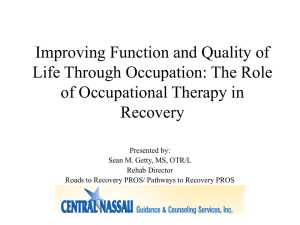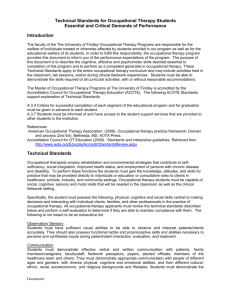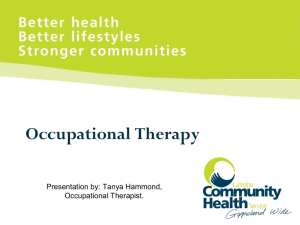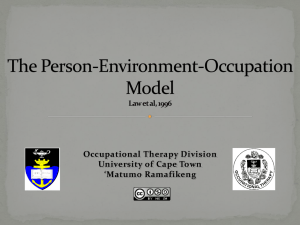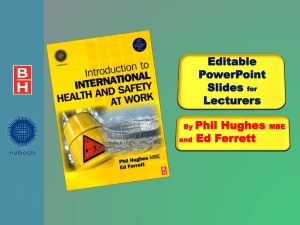Occupational Therapy
advertisement
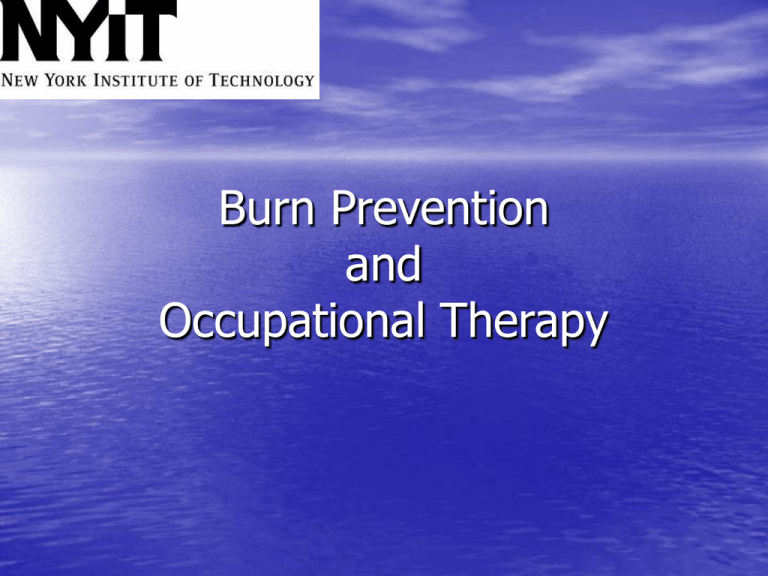
Burn Prevention and Occupational Therapy Occupational Therapy • Occupational therapy helps people achieve independence by assisting with the physical and emotional skills they need for work, play, self-care, travel, learning, and even relaxation. Occupational Therapy • An occupational therapist's work includes helping patients develop daily living, leisure, and work skills; administering tests; and evaluating patients’ progress, all in tandem with other members of professional health care teams. OTs must have expertise in human anatomy and physiology, and natural, physical, and behavioral sciences. Who Benefits From Occupational Therapy? • Wellness programs • Age-related illness • Neurological • • • • • dysfunction Cardiac dysfunction Work-related injuries Arthritis Multiple sclerosis Serious chronic conditions • Mental illness • Substance abuse or eating • • • • • • disorders Burns Spinal cord injuries Amputations Sports injuries Vision impairments Cognitive impairment The Occupational Therapy Program • Combined BS/MS option offers opportunity to students at all educational levels • Prerequisite coursework • The following courses were required as prerequisites for admission into the NYIT Occupational Therapy Department: – Biology, Chemistry, College Algebra and Trigonometry, Human Physiology, Physics, English, Anthropology, Ethics, Psychology, Statistics Why Occupational Therapy? • Government statistics indicate that occupational therapy is one of the most in-demand professions in the U.S., with rapid growth expected throughout the next decade. Your NYIT degree will prepare you to work as an OT in medical facilities, private practices, schools, and businesses. You’ll also be prepared for state and professional licensing exams, and for postgraduate study in a variety of health care professions. Admission Criteria • Students completed an essay • Two professional letters of recommendation • Academic excellence in the sciences • A personal interview • An on-site essay on an assigned topic Fieldwork • Fieldwork – Upon completion of academic coursework, students engage in on-the-job training. Fieldwork is synonymous with the concept of internship. Students participate in fieldwork assignments that can take them as far west as California. – Fieldwork can be done at a variety of settings • Hospitals or Medical Centers • Nursing Homes • Psychiatric Facilities • Community Agencies • Industrial Settings • School Systems Occupational Therapy • An occupational therapy program is individually designed to help restore lost function from an injury or illness, learn life style modification, or develop new skills that will help be independent with your work, play-leisure, or self-care activities. Occupational Therapy When skill and strength cannot be developed or improved, an occupational therapist can offer a creative solution or alternatives for carrying out daily activities. SKIN Epidermis Dermis Subcutaneous Fat Children 0–18 months • Epidermis is loosely connected to the dermis • Variations in different regions http://www.images.md/users/i mage_show.asp SKIN FUNCTIONS • Protects against infection • Prevents loss of bodily fluids • Controls body temperature • Sensory organ • Excretory organ • Produces vitamin D • Influences body image How Severe is the Burn? • Depth • Size • Location • Age • Health • Injury source Medical Intervention http://www.images.md/users/image_show.asp Superficial Partial Thickness Burn www.emedicine.com/ aaem/topic78.htm Deep Partial Thickness Burn http://www.images.md/users/ image_show.asp Full Thickness Burn http://www.images.md/use rs/image_show.asp www.emedicine.com/ed /topic3401.htm RISK FACTORS • Healing time > 14 days • Grafted regions • Very young children • Re-harvested donor site • Ethnic groups • Area of body www.burnsurgery.org/.../ remold_phase.htm Potential Dangers • Fireworks • Candles • Campfires • Hot coal • BBQ grills • Unchecked smoke detectors • Irons • Vaporizers • Lighters • Electrical wires • Internet • Nail polish • Treadmills • Car lighters
